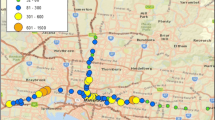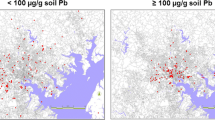Abstract
Airborne Pb settles out and accumulates on the ground. In this way soil has become a major reservoir of Ph. The New Orleans Lead study is based on previous empirical studies of several cities. None of the cities are mining towns nor do they have primary smelting facilities. The first study was conducted in Baltimore, MD, and showed that the location of soil Pb is related to urban geography, with the highest levels clustered within the inner-city. The statistical measure of inner-city clustering was extremely significant (p-value<10−23). Research in Minnesota confirmed the fact that amount of soil Pb is a function of city location and furthermore, that the amount of soil Pb is a function of city size. In Minnesota, two independent projects undertaken in Minneapolis and St. Paul provided information to refine collection techniques. It was concluded that 10 to 15 samples, collected from the top 2 cm soil surface, organized by sample type, and stratified by census tract, were sufficient to map a city. The techniques are being applied to New Orleans and preliminary data confirm fundamental differences (p-value ⋘ 10−6) between various communities. A method for mapping soil Pb in residential communities of urban environments has been achieved.
Similar content being viewed by others
Bibliography
Amitai, Y., Graef, J., Brown, M., Gerstle, R., Kahn, N. and Cochrane, P. (1987) ‘Hazards of ‘Deleading’ Homes of Children with Lead Poisoning’, AJDC 141, 758–760.
Angle, C., McIntire, M., and Vest, G. (1975) ‘Blood Lead of Omaha School Children — Topographical Correlation with Industry, Traffic and Housing’, Neb. Med. J. 60, 97–102.
ATSDR. (1988) The Nature and Extent of Lead Poisoning in the United States: A Report to Congress, U.S. Department of Health and Human Services, Atlanta, Georgia.
Bellinger, D., Leviton, A., Waternaux, C., Needleman, H., and Rabinowitz, M. (1987) ‘Longitudinal Analysis of Prenatal and Postnatal Lead Exposure and Early Cognitive Development’, New Engl. J. Med. 316, 1037–1043.
Chisolm, J., Mellits, E., and Quaskey, S. (1985) ‘The Relationship Between Level of Lead Absorption in Children and the Age, Type and Condition of Housing’, Environ. Res. 38, 31–45.
Day, J. P. (1977) ‘Lead pollution in Christchurch’, N.Z. Journal of Science 20, 395–406.
Farfel, M.R. and Chisolm, Jr., J.J. (1990) ‘Health and Environmental Outcomes of Traditional and Modified Practices for Abatement of Residential Lead-Based Paint’, Am J. Public Health 80, 1240–1245.
Fergusson, J.E., Hayes, R.W., Yong, T.S. and Thiew, S.H. (1980) ‘Heavy metal pollution by traffic in Christchurch, New Zealand. Lead and cadmium content of dust, soil, and plant samples’, N.Z. Journal of Science 23, 293–310.
Fulton, M., Raab, G., Thomson, G., Laxen, D., Hunter, R. and Hepburn, W. (1987) ‘Influence of Blood Lead on the Ability and Attainment of Children in Edinburgh’, Lancet May 30, 1987, 1221–1225.
Mielke, H.W. (1981) ‘The application of Landsat, Geochemical, and Phytogeographical Methods to Mineral Exploration in Vegetated Regions’, Pecora VII Symposium, American Society of Photogrammetry, Falls Church, Va.
Mielke, H.W. and Adams, J. (1989) Environmental Lead Risk in the Twin Cities, Center for Urban and Regional Affairs, H H Humphrey Center, University of Minnesota, Minneapolis, Minnesota.
Mielke, H.W., Adams, J.L., Reagan, P.L., and Mielke, Jr., P.W. (1989) ‘Soil-dust Lead and Childhood Lead Exposure as a Function of City Size and Community Traffic Flow: The Case for Lead Abatement in Minnesota’, Env. Geochem. and Health Lead in Soil (Supplement) 9, 253–271.
Mielke, H.W., Anderson, J., Berry, K., Mielke, Jr., P., Chaney, R., and Leech, M. (1983) ‘Lead Concentrations in Inner-city Soils as a Factor in the Child Lead Problem’, American Journal of Public Health 73 (12), 1366–1369.
Mielke, H.W., Blake, B., Burroughs, S., and Hassinger, N. (1984) ‘Urban Lead Levels in Minneapolis: The Case of the Hmong Children’ Environ. Res. 34, 64–76.
Mielke, H.W., Burroughs, S., Wade, R., Yarrow, T., and Mielke, Jr., P. (1984/85), ‘Urban Lead in Minnesota; Soil Transect Results of Four Cities‘, Minnesota Academy of Science 50 (1), 19–24.
Mielke, P. W. Jr. (1986) ‘Non-metric Statistical Analyses: Some Metric Alternatives’, J. Statistical Planning and Inference 13, 377–387.
MN 1985 Laws, First Special Session, Chapter 14, Article 19, Section 11.
Needleman, H.L. (1987) ‘Low Level Lead Exposure and Children's Intelligence: AQuantitative and Critical Review of Modem Studies’, in: S.E. Lindberg, S.E. and T.C. Hutchison (eds.), Heavy Metals in the Environment, CEP Consultants Ltd, Edinburgh, Vol. 1., pp. 1–8.
Needleman, H.L., Schell, A., Bellinger, D., Leviton, A., and Allred, E.N. (1990) ‘The long-term effects of exposure to low doses of lead in childhood. An 11-year follow-up report’, N.Engl J Med 322 (2), 83–88.
NCHS: (1984) ‘Blood Lead Levels for Persons 6 Months to 74 Years’, Vital & Health Statistics 11 (233), 29–31.
Rosner, D. and Markowitz, G. (1985) ‘Gift of God?: The Public Health controversy over leaded gasoline during the 1920's’, Am J. Pub. Health. 75(4), 344–352.
Sayre, J. (1987) ‘Deleading Houses: Danger in the Dust’, AJDC 141, 727–728.
Schneider, D.J. (1986), ‘Lead Poisoning: More than a Medical Problem’, Am. J. Pub. Health 76, 242–246.
Schwartz, J. and Otto, D. (1987), ‘Blood Lead, Hearing Thresholds, and Neurobehavioral Development in Children and Youths’, Arch. Env. Health 42 (3), 153–160.
Vimpani, G. (1985), ‘The Port Pirie Cohort Study: Blood Lead Concentration and Childhood Development Assessment’, in L. Goldwater (ed.), Lead Environmental Health—The Current Issues, Duke Univ., Durham, N.C., pp. 139–146.
Author information
Authors and Affiliations
Rights and permissions
About this article
Cite this article
Mielke, H.W. Lead in residential soils: background and preliminary results of New Orleans. Water Air Soil Pollut 57, 111–119 (1991). https://doi.org/10.1007/BF00282874
Issue Date:
DOI: https://doi.org/10.1007/BF00282874




